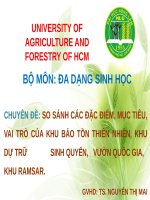English in the USA thuyết trinh môn đa dạng tiếng anh
Bạn đang xem bản rút gọn của tài liệu. Xem và tải ngay bản đầy đủ của tài liệu tại đây (1.4 MB, 42 trang )
English in the USA
Group 7
GROUP MEMBERS
Nguyễn Phước Tuấn Huy
Phạm Uyển Trà My
Trương Vân Anh
Nguyễn Phan Ngọc Anh
Trịnh Mai Trinh
OVERVIEW
01
02
Secrets to understand
fast-talking
Americans?
How to sound more
native?
03
American English Vowels
04
Differences between
American and British
Secrets to understand fast-talking
Americans?
- Americans reduce a lot of sounds when they speak.
Don’t you want to get a coffee later?
→ /Duhwntchuh wanna gedduh coffee layder?/
“Don’t you” → /Duhwntchuh/
“want to” → /wanna/
“get a” → /gedduh/
25 common reduce words
1. The
2. Are
3. And
4. Of
5. A
6. To
7. Was
8. That
9. For
10. You
11. He
12. At
13. But
/ðə/
/ər/
/ən/
/ə/
/ə/
/tə/
/wəz/
/ðət/
/fər/
/yə/
/i/
/ət/
/bət/
14. His
/ɪz/
15. From
/frəm/
16. Or
/ər/
17. As
/əz/
18. Their
/ðər/
19. Can
/kən/
→ to distinguish from Can't
20. Her
/ər/
21. Them
/ərm/
22. Him
/ɪm/
23. Your, you're /yər/
24. Than
/ðən/
25. Our
/ar/
26. An
/ən/
19 common words Pairs
that reduce
11. Lots of → lotsa
12. Out of → oudda
13. Type of → typa
14. Front of → frunna
15. Could have → coulda
16. Should have → shoulda
17. Would have → woulda
18. Might to → mighda
19. Must have → musta
How to understand?
- Don’t depend on slow english.
Try to study English the way it’s really spoken.
- Do listening exercises.
- Flood your brain with audio in English.
Movies, American radio stations, and TV series
are useful.
Shadow reading
1. Get the transcript of the audio
you listen to.
2. As you listen, you read with
the speaker.
You match the
speaker’s speed,
intonation, everything.
How to sound
more native?
Use contractions
• Am, is, are
He is → He's
She is → She's
It is → It's
I am → I'm
's' pronounce like /z/ (end by voice sound)
/s/ (end by voiceless sound)
Eg: She's walking on the street.
I'm ready for a party.
You are → You're /jʊr/ → /jər/
They are → They're /ðeər/ → /ðer/
are → We're /wɪər/ → /wər/
Eg: We're the coolest people.
You're welcome to come along.
We
• Not → n't ( when pronounce you can't hear the /t/ sound)
- Use in writing and speaking
- 2 ways to present negative form
→
Eg:
You are not → You're not / You aren't
He is not → He's not / He isn't
You can't say he's n't or you're n't
She isn't the only one who's knows about this.
It isn't easy as you think.
• Will → 'll
He will →
It will
→
We will →
They will →
He'll
It'll
We'll
They'll
Eg: I bet they'll win this match.
Because of heavy rain, she'll be late for half an hour.
• Reduce ' to '
Wanna (want to) and Gonna (going to)
I
You
We
They
+ wanna
Some mistakes:
I gonna
He gonna
We gonna
→
→
→
I’m gonna
He’s gonna
We’re gonna
He
She
It
+ wansta.
Changes in pronunciation of words that end in
T or D when the next word starts with Y or
the "yuh" sound.
T + Y → CH {t∫}.
Some examples:
Get you → getcha
Get your → getcher
Can't you → can'tcha
Haven't you → haven'tcha
D + Y → J {dʒ}
Some examples:
Tried your → triedjer
Had your → hadjer
Told you → toldja
Made you → madeja
How did you → how'dja
How did your → how'djer
Did you
→ didja
Who did you → who'dja
What did you → whatdja
Where did you → where'dja
When did you → whenja
Why did you → why'dja
→ ( "did you" sometimes reduce down even further and become just "ja" especially in question
words paired with the word did and the word you).
American English
Vowels
Emerican English Vowel Sound: t
One of the most common consonant sounds in the English language.
4 different t sounds in American English
01
02
True T
Flap T
03
04
Held T
Vanishing T
True T:
clear, concise, distinct
- Beginning of words: to tell
take
- Beginning of stressed or emphasized syllables: until
hotel
return
- In consonant clusters ( when two consonant sounds occur right next to each
other and you say them both):
st
str
tr
ct
→ stop, best
→ street
→ tree
→ fact
ft → lift
lt → melt
pt → kept
Flap T:
a /d/ sound
- When t is in the middle of words in between two vowel sounds.
Water: w-a-t-e-r → “wa-der”
City:
c-i-t-y
→ “ci-dy”
Later:
l-a-t-e-r
→ “la-der”
- When one word ends in a vowel sound and t and the next word
starts with a vowel sound: what is → “wa-dis”
Held T:
- At the end of words in American English: about it was
- At the end of a syllable when the next syllable starts with a
consonant sound: outside apartment
- Cluster in t at the end of words doesn’t follow the true t like other
consonant clusters > the nt at the end of words > hear a held t
Student
President
Vanishing T:
disapears completely
- When the t comes after the /n/ or in sound in an unstressed syllable
- After the n sound:
internet → “innernet”
printer → “prinner”
American English Vowel Sound: /ʊ/, UU
Eg:
Could /kʊd/
Wolf
/wʊlf/
Bull
/bʊl/
Withstood /wɪθˈstʊd/
Push
/pʊʃ/
American English Vowel Sound: /ɑ/, AH
Eg:
Problem
Beyond
Hospital
/ˈprɑːbləm/
/bɪˈjɑːnd/
/ˈhɑːspɪtl/
Process /ˈprɑːses/
Modern /ˈmɑːdərn/









